Introduction
The commercial cultivation of sour cherries has been abandoned for years in Greece due to the low market price and high harvesting costs, as well as the fact that they are cultivated in the same regions as cherries, which have a more satisfactory profit.
The last geographical area where sour cherries are systematically cultivated in Greece is in Arcadia (in the areas of Tegea and Tripoli). They are cultivated more sporadically in some areas with a tradition of cultivation, such as Florina, Pelion, Lamia, Agia Larissa, Serres, etc., as well as in individual trees in gardens and orchards scattered throughout Greece for use in the production of homemade processed products (e.g., traditional sour cherry or desserts).
Recently, there has been increased commercial interest due to the attempt to utilize all the fields abandoned due to urbanization. Interest has also been rekindled for the supply of sour cherries in small outdoor markets. In general, it could be said that Greece is lacking in the production and supply of sour cherries, which could be used by processing industries as well as for export to Eastern European countries where they are a highly appreciated food.
The deterrent factor, which is the high cost of harvesting, can be addressed by modernizing the crops, mainly through the use of cultivation systems and varieties that allow for mechanical harvesting of the fruit. The domestic genetic material of sour cherries in Greece is limited to a few varieties, the main ones of which are briefly presented below, along with a large number of local genotypes.
It should be noted that Greek sour cherry varieties are classified into “amareno” (mainly) and “marasche” types, based on the Italian way of categorizing sour cherry varieties.
2.1. Constantinopoli
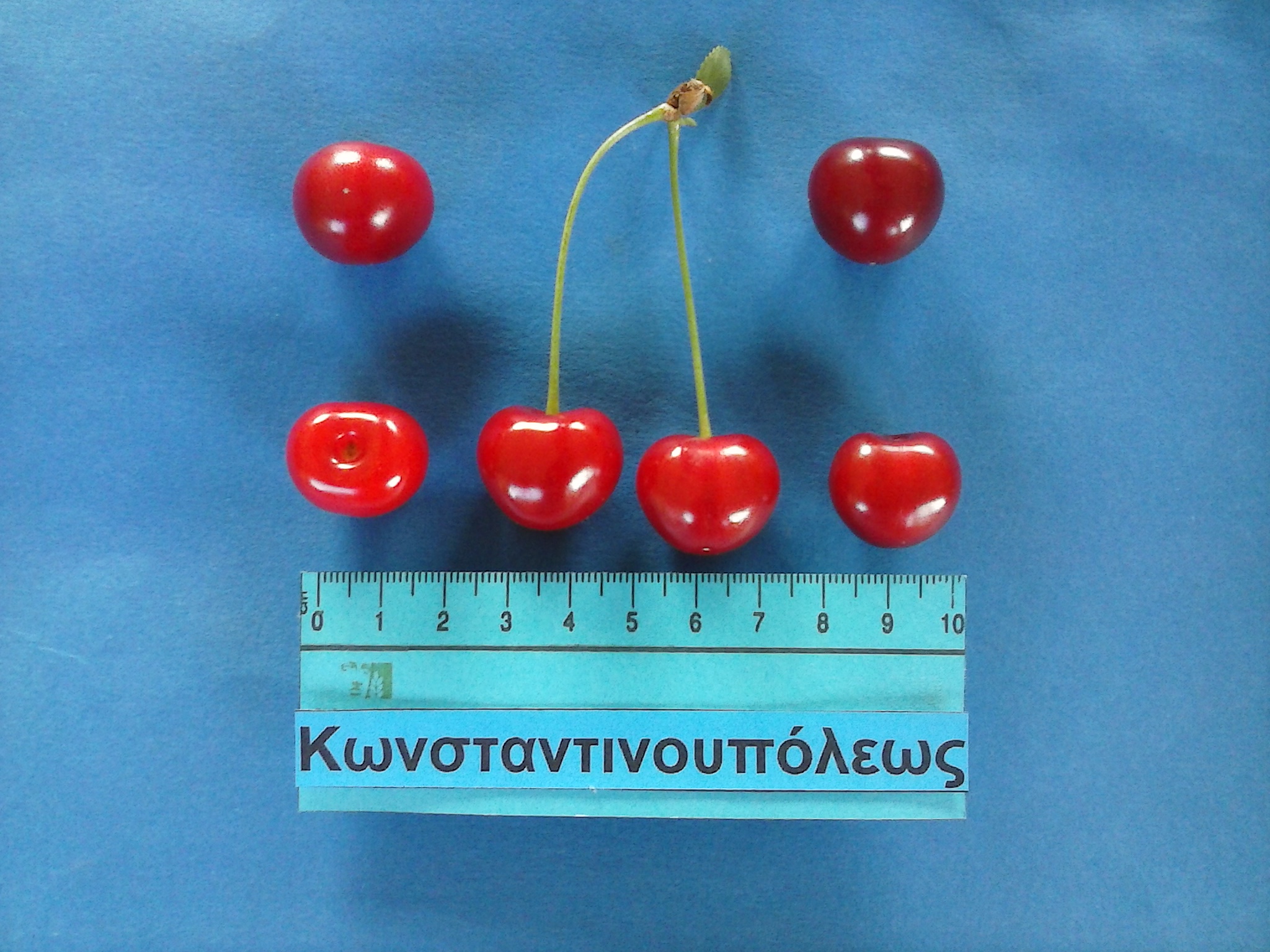 Image 1.
Image 1.
- Synonyms: Politica.
- General: Red variety, soft texture.
- Origin and distribution: Probably originates from the Istanbul area, as the name suggests. Currently, its distribution is mainly limited to trees scattered in gardens and cherry orchards throughout Greece.
- Tree: Very vigorous, upright.
- Productivity: Very high.
- Fruit: Flattened spherical, large size (average 5.5 g), with a large peduncle, sour to slightly bitter taste, and high juice content.
- Maturation period: Early June (mid-early).
- Special features – Strengths – Vulnerabilities: Displays parafilla on the peduncle. Presents few twin fruits, which vary depending on the year.
- Conclusions: Productive variety suitable for processing industries where the pit is relatively easy to remove from the fruit.
2.2. Florinis
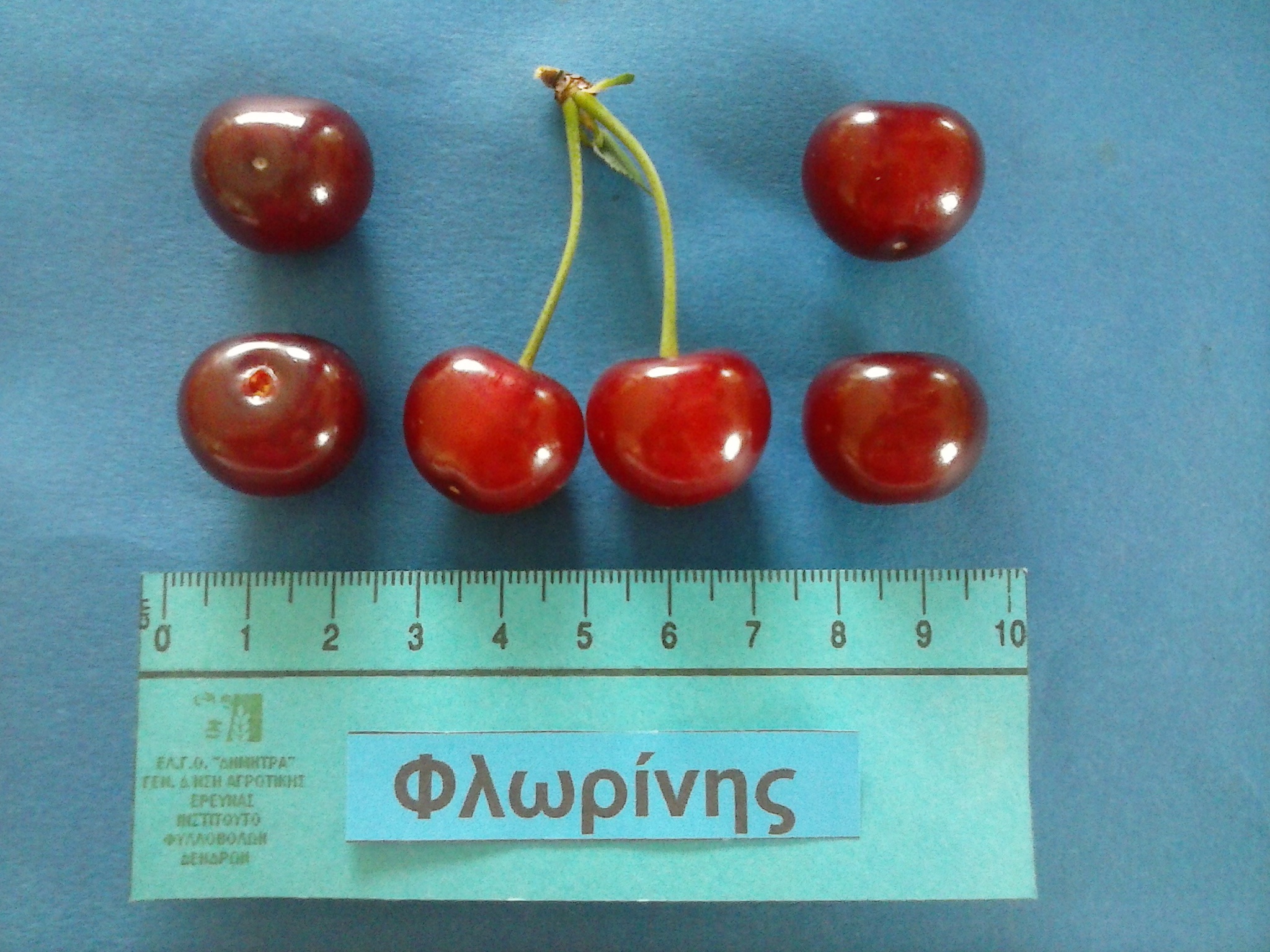 Image 2.
Image 2.
- General: Dark red variety, soft texture.
- Origin and distribution: Originates from the highlands of Florina, as the name suggests. Previously the most widespread sour cherry variety in northern Greece, it occupied 1/3 of the complex cultivation areas of sour cherries in Greece. Today, however, it is limited to orchards and scattered trees.
- Tree: Very vigorous, upright.
- Productivity: High.
- Fruit: Spherical, medium size (average 4.8 g), with a sour taste and high juice content.
- Maturation period: Second decade of June (late).
- Special features – Strengths – Vulnerabilities: The fruit can remain on the tree for several days without being harvested on time. Resistant to transport and maintenance. Susceptible to gray rot (Monilinia).
- Conclusions: Excellent variety for juicing with a lot of juice and high acidity content. The fruit is not easily harvested by shaking.
2.3. Kanaris
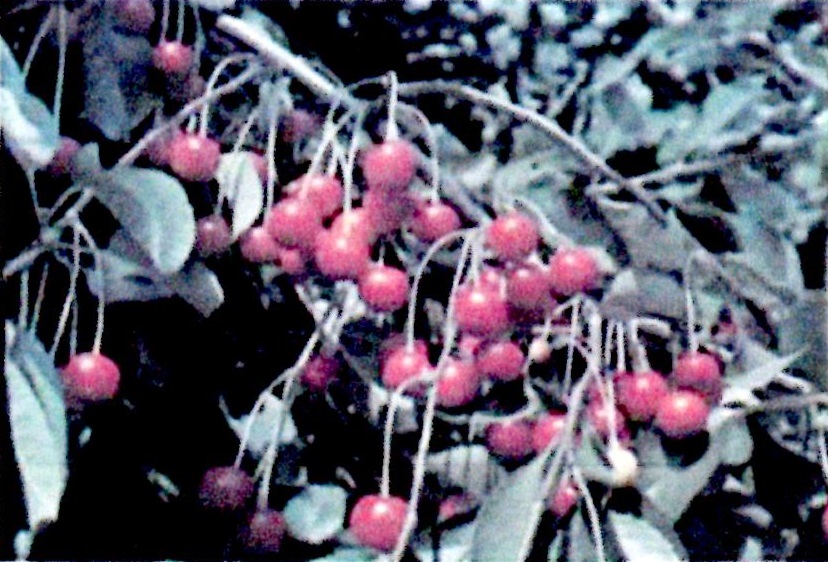 Image 3.
Image 3.
- General: Red variety, soft texture.
- Origin and distribution: Greek variety with an unidentified area of origin. Currently, its distribution is very limited. Found in scattered trees in gardens and cherry orchards. It was more widespread in the past.
- Tree: Medium vigor, upright.
- Productivity: Very high.
- Fruit: Flattened oval, large size (average 5.5 g), with a very large peduncle, rich sour taste, and high juice content.
- Maturation period: Second week of June (mid-season).
- Special features – Strengths – Vulnerabilities: The fruit can remain on the tree for several days without being harvested on time. Resistant to transport.
- Conclusions: Excellent variety for juicing with a lot of juice and high acidity content. The fruit is not easily harvested by shaking.
2.4. Tripoleos
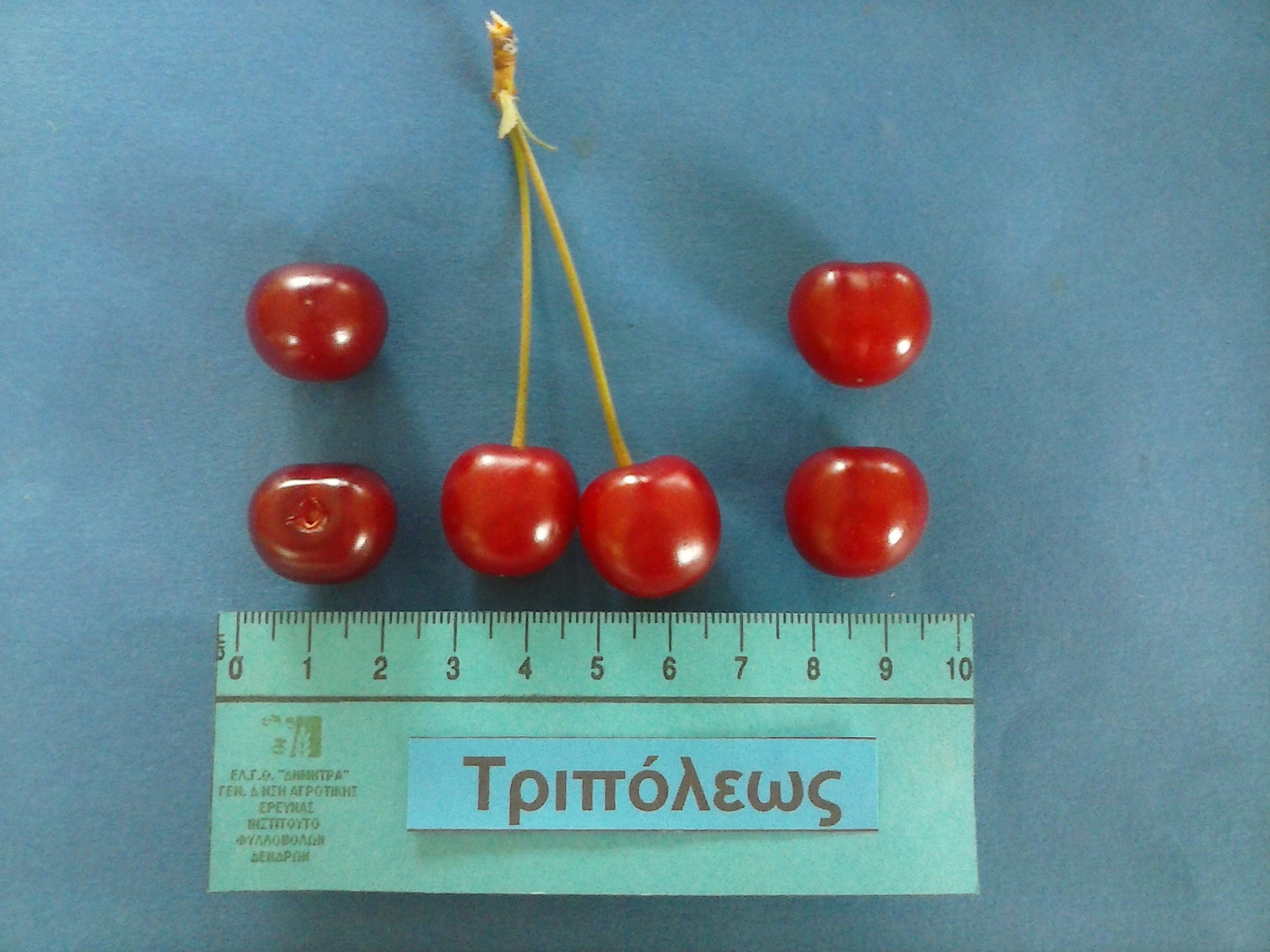 Image 4.
Image 4.
- Synonyms: Tegeas.
- General: Red variety, soft texture.
- Origin and distribution: Originates from the region of Arcadia, as the name suggests. Cultivated in the areas of Tegea and Tripoli and less intensively in other areas of the Peloponnese.
- Tree: Very vigorous, with lateral branches.
- Productivity: Very high.
- Fruit: Spherical to apple-shaped, medium size (average 4.6 g), with a large peduncle, sour taste, and high juice content.
- Maturation period: Mid-June (late).
- Special features – Strengths – Vulnerabilities: Shows many large parafilla on the peduncle. Presents twin fruits.
- Conclusions: Productive variety, suitable for processing (industrial or domestic). Easily absorbed in small markets in Athens.
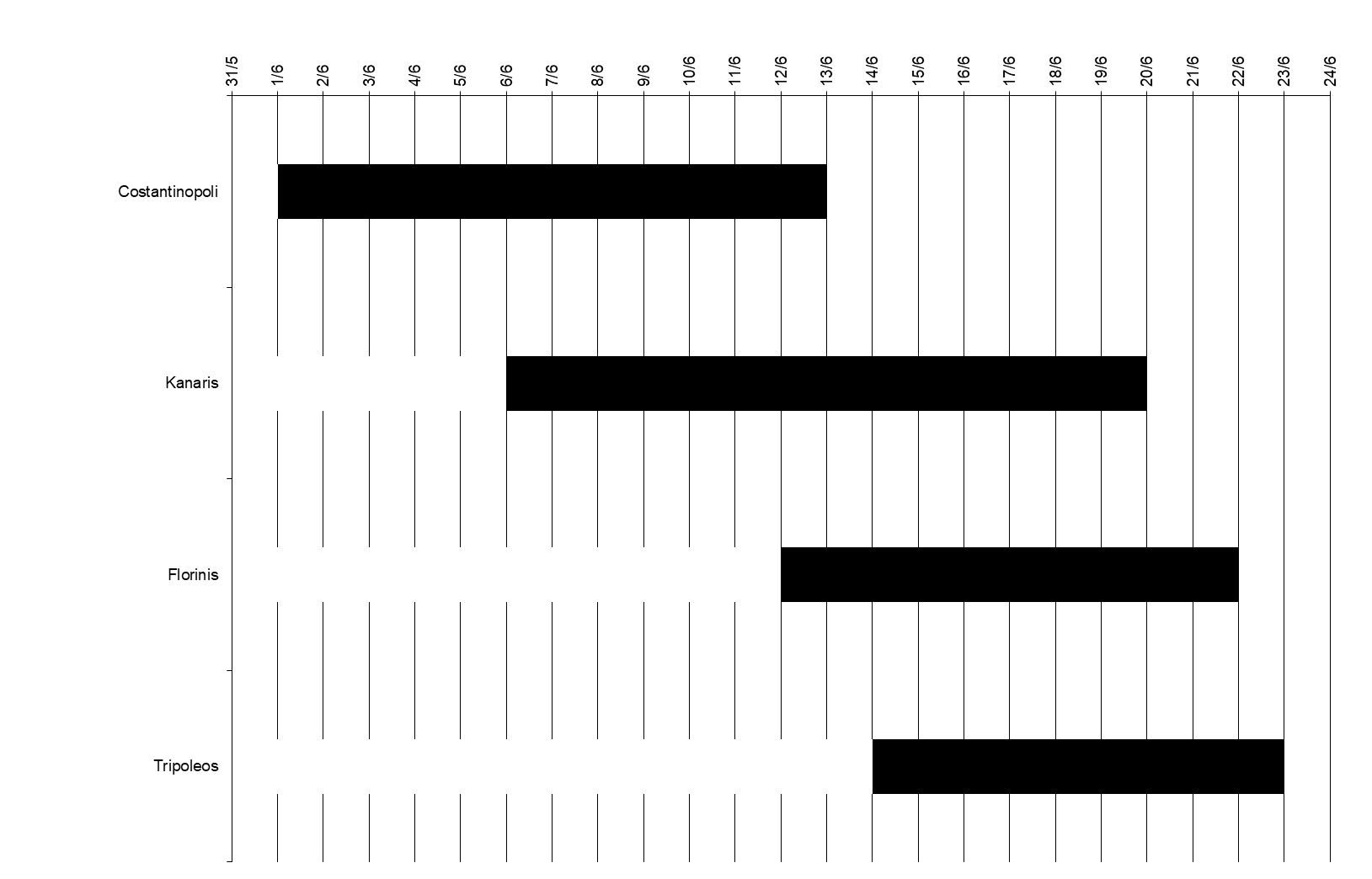 Graph 1: Comparison of the ripening season of the main Greek sour cherry varieties in the northern Greece region.
Graph 1: Comparison of the ripening season of the main Greek sour cherry varieties in the northern Greece region.
Other well-known local Greek sour cherry varieties in the past, but of lesser importance compared to those mentioned above, are Neapoleos and Gerakariou.
3. Conclusions
Greece exports only 350 – 1500 tons of sour cherries annually, mainly to former Eastern European countries. There are prospects for a dynamic resurgence of sour cherry cultivation in Greece if the harvesting cost is reduced by modernizing cultivation with varieties that can be mechanically harvested.
Apart from the localized geographical area of sour cherry cultivation in the Arcadia region, covering an area of over 50 hectares (Tripoleos variety), sour cherries can be found throughout Greece, mainly in gardens as individual trees for use in homemade preparations (juices, jams, spoon sweets, etc.). There are a large number of local genotypes with completely different fruit characteristics, well-acclimatized to their cultivation areas.

Image 5 - Indicative photos of local Greek sour cherry genotypes, Episkopi of Naoussa (left) and the island of Samos (right).
Konstantinos Kazantzis
Agronomist, ELGO - DIMITRA, Institute for Deciduous Plants of Naoussa, Greece
Cherry Times - All rights reserved


















